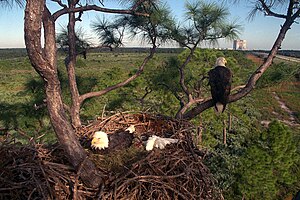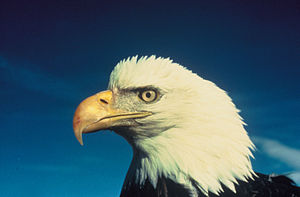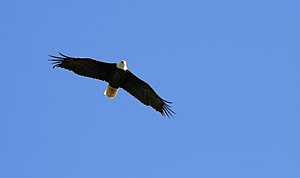Difference between revisions of "Field Guide/Birds/Haliaeetus leucocephalus"
(No difference)
|
Revision as of 15:02, 15 November 2006
The Bald Eagle (Haliaeetus leucocephalus), also known as the American Eagle, is a bird of prey found in North America, most recognizable as the national bird of the United States.
The species was on the brink of extinction in the USA late in the 20th century, but now has a stable population and is in the process of being removed from the U.S. federal government's list of endangered species.
This eagle gets both its common and scientific names from the distinctive appearance of the adult's head. Bald in the English name refers to the white head feathers, and the scientific name is derived from Haliaeetus, the New Latin for "sea eagle," (from the Greek haliaetos) and leucocephalus, the Greek for "white head," from leukos ("white") and kephale ("head").
Range, habitat, and restoration
The Bald Eagle's natural range covers most of North America, including most of Canada, all of the continental United States, and northern Mexico. The bird itself is able to live in most of North America's varied habitats from the bayous of Louisiana to the Sonoran desert and the eastern deciduous forests of Quebec and New England. It can be a migratory bird but it also is not unheard of for a nesting pair to overwinter in its breeding area.
Once a common sight in much of the continent, the Bald Eagle was severely affected by the use of the pesticide DDT in the mid-twentieth century. While the pesticide itself was not lethal to the bird, it made an eagle either sterile or unable to lay healthy eggs: the eagle would ingest the chemical through its food and then lay eggs that were too brittle to withstand the weight of a brooding adult. By the 1960's there were fewer than 500 nesting pairs in the 48 contiguous states of the USA. Currently it is still slowly but steadily recovering its numbers; Organizations like the (F.O.E.) Fraternal Order of Eagles which carry the Eagle as their emblem, have helped the American Bald Eagle on its recovery, by supporting other groups that rescue and preserve the Eagles and their habitat. The Bald Eagle can be found in growing concentrations throughout the United States and Canada, particularly near large bodies of water. The U.S. state with the largest resident population is Alaska; out of the estimated 980,000 Bald Eagles on Earth, half live there.
Permits are required to keep this species. As a rule, the Bald Eagle is a poor choice for public shows, being timid, prone to becoming highly stressed, and unpredictable in nature.
This species has occurred as a vagrant once in Ireland. The exhausted specimen was discovered by a national parks worker in a northern heath. Presumably, a storm blew it out to sea, and the bird struggled across the Atlantic Ocean.
The only Bald Eagle to be hatched outside North America was born on May 3 2006 in a zoo in the German city of Magdeburg.
Description
An immature Bald Eagle has speckled brown plumage, the distinctive white head and body developing 2–3 years later, before sexual maturity. This species is distinguishable from the Golden Eagle in that the latter has feathers which extend down the legs.
Adult females have an average wingspan of about 2.1 meters (7 feet); adult males have a wingspan of 2 meters (6 feet, 6 inches). Adult females weigh approximately 5.8 kg (12.8 lb), males weigh 4.1 kg (9 lb). The smallest specimens are those from Florida, where an adult male may barely exceed 2.3 kg (5 lb) and a wingspan of 1.83 meters (6 feet). The largest are of the Alaskan races, where large females may exceed 7 kg (15.5 lb) and have a wingspan of approximately 2.4 meters (8 feet). Bald Eagles are powerful fliers, and also soar on thermal convection currents.
In the wild, Bald Eagles can live about 20 - 30 years, and have a maximum life span of approximately 50 years. They generally live longer in captivity; up to 60 years old.
Bald Eagles normally squeak and have a shrill cry, punctuated by grunts. They do not make the "eagle scream" as often shown on television. What many recognize as the call of this species is actually the call of a Red-tailed Hawk dubbed into the film.
Reproduction
Bald Eagles build huge nests out of branches, usually in large trees near water. The nest may stretch as large as eight feet across and weigh up to a ton (907kg). When breeding where there are no trees, the Bald Eagle will nest on the ground.
Eagles that are old enough to breed often return to the area where they were born. An adult looking for a site is likely to select a spot that contains other breeding Bald Eagles.
Bald Eagles are sexually mature at 4 or 5 years old. Eagles produce between one and three eggs per year, but it is rare for all three chicks to successfully fly. Both the male and female take turns sitting on the eggs. The other parent will hunt for food or look for nest material. The male might eat an eaglet if the mother is not around.
Diet
The Bald Eagle's diet is varied, including carrion, fish, smaller birds, rodents, and sometimes food scavenged or stolen from campsites and picnics.
To hunt fish, the eagle swoops down over the water and snatches the fish out of the water with its talons. They eat by holding the fish in one claw and tearing the flesh with the other. Eagles have structures on their toes called spiricules that allow them to grasp fish. Osprey also have this adaptation.
Sometimes, if the fish is too heavy to lift, the eagle will be dragged into the water. It may swim to safety, but some eagles drown or succumb to hypothermia.
National bird of the U.S.
The Bald Eagle is the national bird of the United States of America. It is probably one of the country's most recognizable symbols, and appears on most of its official seals, including the Seal of the President of the United States.
Its national significance dates back to June 20, 1782, when the Continental Congress officially adopted the current design for the Great Seal of the United States including a Bald Eagle grasping arrows and an olive branch with its talons. Some states had earlier adopted the bird as a symbol; for example New York State did so in 1778.
In 1784, after the end of the Revolutionary War, Benjamin Franklin wrote a famous letter to his daughter from Paris criticizing the choice and suggesting the Wild Turkey's character as a desirable trait:
- For my own part I wish the Bald Eagle had not been chosen the Representative of our Country. He is a Bird of bad moral character. He does not get his Living honestly. You may have seen him perched on some dead Tree near the River, where, too lazy to fish for himself, he watches the Labour of the Fishing Hawk; and when that diligent Bird has at length taken a Fish, and is bearing it to his Nest for the Support of his Mate and young Ones, the Bald Eagle pursues him and takes it from him.
- With all this Injustice, he is never in good Case but like those among Men who live by Sharping & Robbing he is generally poor and often very lousy. Besides he is a rank Coward: The little King Bird not bigger than a Sparrow attacks him boldly and drives him out of the District. He is therefore by no means a proper Emblem for the brave and honest Cincinnati of America who have driven all the King birds from our Country . . .
- I am on this account not displeased that the Figure is not known as a Bald Eagle, but looks more like a Turkey. For the Truth the Turkey is in Comparison a much more respectable Bird, and withal a true original Native of America . . . He is besides, though a little vain & silly, a Bird of Courage, and would not hesitate to attack a Grenadier of the British Guards who should presume to invade his Farm Yard with a red Coat on.
Despite Franklin's objections, the Bald Eagle remained the emblem of the United States. It can be found on both national seals and on the back of several coins (including the quarter dollar coin until 1999), with its head oriented towards the olive branch.
Bald Eagles as religious objects
The Bald Eagle is a sacred bird in some North American cultures and its feathers, like those of the Golden Eagle, are central to many religious and spiritual customs amongst Native Americans. Some Native Americans revere eagles as sacred religious objects, including the feathers and other parts and are often compared to the Bible and crucifix (See References).
Eagle feathers are often used in traditional ceremonies and are used to honor noteworthy achievements and qualities such as exceptional leadership and bravery.
Despite modern and historic Native American practices of giving eagle feathers to non-Native Americans and Native American members of other tribes who have been deemed worthy, current eagle feather law stipulates that only individuals of certifiable Native American ancestry enrolled in a federally recognized tribe are legally authorized to obtain Bald or Golden Eagle feathers for religious or spiritual use.
References
- Associated Press, Native American gets OK to use eagle feathers in religious practices (2002)[1]
- Associated Press, Residents fight to use eagle feathers (2004) [2]
- Boradiansky, Tina S. Conflicting Values: The Religious Killing of Federally Protected Wildlife (1990)[3]
- DeMeo, Antonia M. Access to Eagles and Eagle Parts: Environmental Protection v. Native American Free Exercise of Religion (1995)[4]
- Template:IUCN2006 Database entry includes justification for why this species is of least concern
- Electronic Code of Federal Regulations (e-CFR), Title 50: Wildlife and Fisheries PART 22—EAGLE PERMITS
External links
- Bald Eagle at BirdHouses101.com
- 1.24 Mb Bald Eagle JPEG (U.S. Fish & Wildlife Service)
- Ben Franklin - the Eagle and the Turkey
- Live web cam of a Bald Eagle nest in British Columbia
- Live web cam of a Bald Eagle nest in Massachusetts
- Bald Eagle Information
- Cascades Raptor Center
be:Белагаловы арол cr:ᒥᒋᓲ cs:Orel bělohlavý da:Hvidhovedet havørn de:Weißkopfseeadler es:Pigargo cabeciblanco eo:Blankkapa maraglo fr:Pygargue à tête blanche it:Haliaeetus leucocephalus he:עיטם לבן ראש nl:Amerikaanse zeearend ja:ハクトウワシ pl:Bielik amerykański pt:Águia de cabeça branca sk:Orliak bielohlavý fi:Valkopäämerikotka sv:Vithövdad havsörn ta:வெண்தலைக் கழுகு




